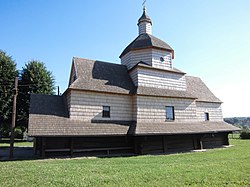world.wikisort.org - Ukraine
Kopychyntsi (Ukrainian: Копичинці, Polish: Kopyczyńce, Yiddish: קאפיטשיניץ) is a small city in Chortkiv Raion, Ternopil Oblast, Ukraine. It hosts the administration of Kopychyntsi urban hromada, one of the hromadas of Ukraine.[1] Kopychyntsi is the birthplace of Vasyl Ivanchuk, a chess grandmaster; Israel Jacob Kligler, who led the effort of eradicating malaria in Mandatory Palestine; and Pinhas Lavon, an Israeli politician. Population: 6,587 (2021 est.)[2]
This article needs additional citations for verification. (May 2017) |
Kopychyntsi
Копичинці Kopyczyńce • קאפיטשיניץ | |
|---|---|
 Church of Exaltation of the Holy Cross | |
 Coat of arms | |
 Kopychyntsi Map of Ukraine with Kopychyntsi highlighted.  Kopychyntsi Kopychyntsi (Ukraine) | |
| Coordinates: 49°06′29″N 25°54′46″E | |
| Country | |
| Oblast | |
| Raion | Chortkiv Raion |
| First mention | 1443 |
| Magdeburg Rights | 1564 |
| Population (2021) | |
| • Total | 6,587 |
| Time zone | UTC+2 (EET) |
| • Summer (DST) | UTC+3 (EEST) |
| Postal code | 48260 |
| Area code | +380 3557 |
| Website | https://kopychyntsi.com.ua |


History
The city was first mentioned in 1340 as a village in the Polish powiat (county) of Terebovlia. With time it grew to become a town within the Land of Halicz, itself part of Podole Voivodeship of Poland and then the Polish–Lithuanian Commonwealth. It was granted a city charter in 1564. In late 1648, during the Khmelnytsky Uprising, a combined Cossack and Tartar army under Asand Demko seized the town. However, following the Battle of Kopychyntsi of May 12, 1651, in which the enemy forces were defeated by hetman Marcin Kalinowski, it returned to Poland.
In the effect of the Treaty of Buchach of 1672 the town was ceded to Ottoman Empire, but it returned to Poland after the Treaty of Karlowitz of 1699. Following the Partitions of Poland it became part of Austrian Empire and was then seized by Napoleon Bonaparte who gave it to Russian Empire in the Treaty of Tilsit of 1807. Russian control however ended with the Congress of Vienna which awarded the area back to Austria. It shared the history of the surrounding lands of the Kingdom of Galicia and Lodomeria for the rest of the 19th century.
Following World War I the area was disputed between Poland and the West Ukrainian People's Republic (ZUNR) in what became known as the Polish-Ukrainian War. In June 1919, during the Chortkiv offensive, the 1st Galician Corps of the ZUNR under Osyp Mykytka seized the town, but it was retaken by Polish forces under Józef Haller the following month. Following the Treaty of Riga the town was officially restored to Poland. It was made a seat of a separate powiat within Tarnopol Voivodeship and a garrison town of a Border Protection Corps battalion Kopyczyńce.
Following the September Campaign of 1939 and the outbreak of World War II, the town was occupied first by the Soviet Union and then Nazi Germany. According to the Soviet Extraordinary Commission, approximately 8,000 Jews were killed in Kopychyntsi during the war.[3] After the war it was annexed by the USSR, and since 1991 is part of independent Ukraine.
Until 18 July 2020, Kopychyntsi belonged to Husiatyn Raion. The raion was abolished in July 2020 as part of the administrative reform of Ukraine, which reduced the number of raions of Ternopil Oblast to three. The area of Husiatyn Raion was merged into Chortkiv Raion.[4][5]
Religion
Houses of worship
- Ukrainian Greek Catholic Church of the Exaltation of the Holy Cross and bell tower (1630), located at Kutets
- Church of St. Nicholas on the Mount (1900), architect Vasyl Nahirny
- Roman Catholic Church of the Assumption of Mary (1802) in the center of the town
- Synagogue
Attractions
- People's House, Kopychyntsi
- Park near the pool, founded in the 18th century;
- Castle (lost).
Notable people
- Vasyl Ivanchuk, Ukrainian chess grandmaster
- Israel Jacob Kligler, Israeli microbiologist
- Mefodiy (Kudriakov)
- Adam Obrubański, Polish football player and manager
- Roman Hubczenko, Polish actor
- Franciszek Slawski, Polish linguist
- Pinhas Lavon, Israeli politician best known for the Lavon Affair
- Mike Mazurki, Ukrainian-American actor
People associated with Kopychyntsi
- Adam Mikołaj Sieniawski
References
- "Копичинецкая громада" (in Russian). Портал об'єднаних громад України.
- Чисельність наявного населення України на 1 січня 2021 [Number of Present Population of Ukraine, as of January 1, 2021] (PDF) (in Ukrainian and English). Kyiv: State Statistics Service of Ukraine.
- "Yahad-In Unum Interactive Map". Execution Sites of Jewish Victims Investigated by Yahad-In Unum. Retrieved 11 February 2015.
- "Про утворення та ліквідацію районів. Постанова Верховної Ради України № 807-ІХ". Голос України (in Ukrainian). 2020-07-18. Retrieved 2020-10-03.
- "Нові райони: карти + склад" (in Ukrainian). Міністерство розвитку громад та територій України.
External links
- (in Ukrainian) Сайт Копичинців
- "Kopeczyńce". Geographical Dictionary of the Kingdom of Poland (in Polish). 4. Warszawa: Kasa im. Józefa Mianowskiego. 1883. p. 377.
- Kopychyntsi, Ukraine at JewishGen
На других языках
[de] Kopytschynzi
Kopytschynzi (ukrainisch Копичинці; russisch Копычинцы .mw-parser-output .Latn{font-family:"Akzidenz Grotesk","Arial","Avant Garde Gothic","Calibri","Futura","Geneva","Gill Sans","Helvetica","Lucida Grande","Lucida Sans Unicode","Lucida Grande","Stone Sans","Tahoma","Trebuchet","Univers","Verdana"}Kopytschinzy, polnisch Kopyczyńce oder älter Kopeczyńce) ist eine Stadt im Westen der Ukraine mit etwa 7000 Einwohner. Die Stadt liegt am Ufer der Niltschawka, etwa 55 km südöstlich der Oblasthauptstadt Ternopil.- [en] Kopychyntsi
[ru] Копычинцы
Копы́чинцы (укр. Копичинці (прослушать (инф.)) — город в Тернопольской области Украины. Входит в Чортковский район (до 2020 года — в Гусятинский район, в котором составлял Копычинский городской совет).Другой контент может иметь иную лицензию. Перед использованием материалов сайта WikiSort.org внимательно изучите правила лицензирования конкретных элементов наполнения сайта.
WikiSort.org - проект по пересортировке и дополнению контента Википедии
